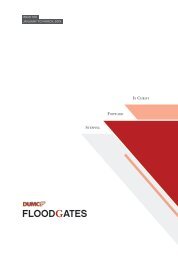Floodgates 101_Issue2_2019_FINAL
Create successful ePaper yourself
Turn your PDF publications into a flip-book with our unique Google optimized e-Paper software.
Features<br />
Parables give us “imaginary gardens with real toads in them”.<br />
While myths give us imaginary gardens with imaginary toads<br />
in them, a parable tells a story which, on the surface level,<br />
is absolutely possible or even factual within the normalcy of<br />
life. A myth tells one which is neither of these on its surface<br />
level.<br />
Parables give us<br />
“imaginary gardens<br />
with real toads<br />
in them”.<br />
THE MOST IMPORTANT OF JESUS’ PARABLES<br />
Of Jesus’ many parables, the Parable of the Sower has been<br />
acknowledged as His most important. According to Lim Kar<br />
Yong in his Jesus the Storyteller: Hearing the Parables Afresh<br />
Today, there are three reasons for this.<br />
Firstly, the Parable of the Sower provides the most amount<br />
of explanation and guidance on how it should be interpreted.<br />
In most of Jesus’ other parables, Jesus leaves a great deal of<br />
homework for His audience to mull on; His audience is meant to<br />
come to its own conclusions. But with the Parable of the Sower,<br />
Jesus provides His own interpretation of the parable’s meaning<br />
to remove most of the ambiguity.<br />
Secondly, the Parable of the Sower is one of the few parables<br />
that appear in all three Synoptic Gospels (Matthew, Luke and<br />
Mark). For example, the very familiar Parable of the Talents<br />
appears only in Matthew (25:14-30) and Luke (19:12-27) and is<br />
absent in Mark, while another familiar parable, the Parable of the<br />
Pharisee and the Tax Collector, is found only in Luke (19:9-14)<br />
and is absent in Matthew and Mark. More on this below.<br />
Thirdly, at the core of the Parable of the Sower (i.e. after He<br />
had told the parable narrative but before He provided His<br />
explanation thereof), Jesus quoted from Isaiah 6:9-10. The<br />
significance of this reference to Old Testament scripture,<br />
especially at this point of Jesus’ ministry, cannot be overstated.<br />
This will be discussed in greater detail below.<br />
MATTHEW AND LUKE, VERSUS MARK<br />
This is how the Parable of the Sower appears in the three<br />
Synoptic Gospels:<br />
Matthew 13:1-23 (NIV) Luke 8:4-18 (NIV) Mark 4:1-20 (NIV)<br />
Background Matthew 13:1-2 Luke 8:4 Mark 4:1-2<br />
Parable Narrative Matthew 13:3-8 Luke 8:5-8a Mark 4:3-8<br />
Reference to Isaiah 6 Matthew 13:9-17 Luke 8:8b-10 Mark 4:9-12<br />
Explanation Thereof Matthew 13:18-23 Luke 8:11-18 Mark 4:13-20<br />
On the surface, it seems that all three Synoptic Gospels<br />
recorded this parable with a high degree of consistency. Even<br />
the structure of the parable is consistent across all three books<br />
– they all begin with a brief introduction of the setting in which<br />
Jesus spoke this parable, followed by the parable narrative itself,<br />
25







